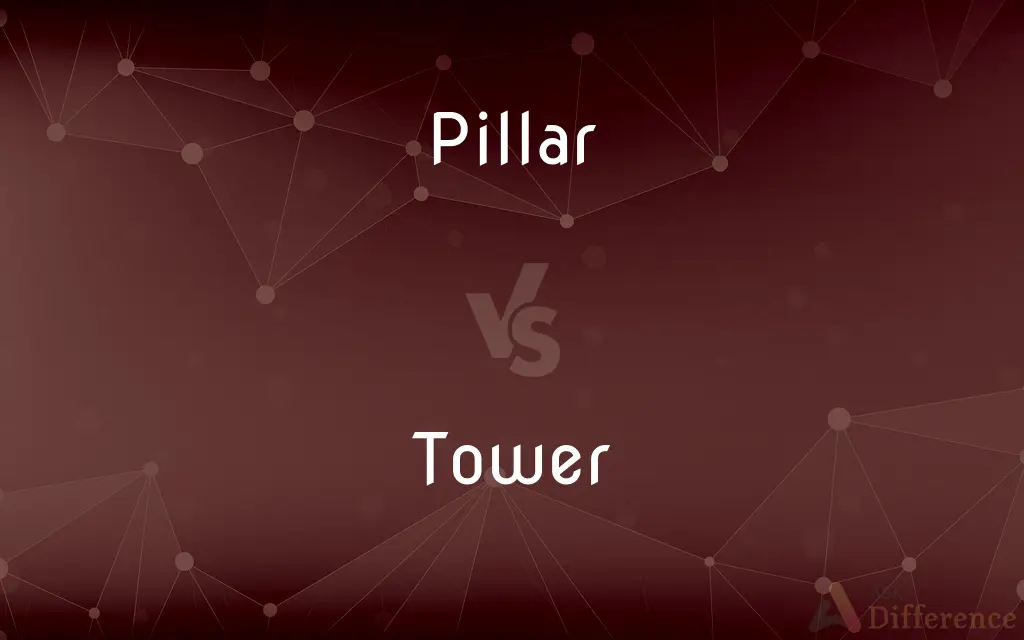Pillar vs. Tower — What's the Difference?
By Tayyaba Rehman & Fiza Rafique — Updated on March 26, 2024
A pillar is a vertical, structural element, often used for support or decoration, whereas a tower is a tall, slender building or structure, typically standing much higher than its diameter.

Difference Between Pillar and Tower
Table of Contents
ADVERTISEMENT
Key Differences
Pillars are primarily used as support in buildings or structures, bearing loads from the structure above, or they can be decorative, standing as monuments or memorials. Towers, on the other hand, are built to stand tall for purposes such as observation, communication, or as a symbol of architectural achievement, often dominating the skyline.
While pillars are integral to the construction of various structures, providing support and stability, towers are usually standalone structures or significant parts of buildings designed for a specific use, such as bell towers or watchtowers. This distinction underscores the functional difference between the two, with pillars being fundamental to structural integrity and towers serving a broader range of purposes.
The design of a pillar is often cylindrical or square, with a focus on strength and the ability to distribute loads. Towers have a more varied architecture, ranging from medieval stone towers to modern steel and glass designs, showcasing technological advances and aesthetic preferences. This architectural diversity reflects the difference in their roles and the eras they represent.
In terms of construction materials, pillars have been made from stone, brick, wood, or concrete, chosen for their load-bearing capabilities. Towers, while also using similar materials, may incorporate more diverse or advanced materials like steel or reinforced concrete, enabling greater heights and more innovative designs.
The symbolism of pillars and towers also diverges; pillars can symbolize stability, support, and sometimes historical or religious significance. Towers often symbolize ambition, power, and technological progress, reaching skyward as if to transcend earthly limits.
ADVERTISEMENT
Comparison Chart
Primary Function
Supportive or decorative in structures.
Standalone or part of a structure for various uses.
Design
Cylindrical or square, focused on strength.
Varied, often tall and slender, symbolizing ambition.
Materials
Stone, brick, wood, concrete for load-bearing.
Includes advanced materials for height and design.
Symbolism
Stability, support, historical significance.
Ambition, power, technological progress.
Examples
Greek temple columns, memorial pillars.
Eiffel Tower, watchtowers, bell towers.
Compare with Definitions
Pillar
A vertical support structure in architecture.
The ancient temple was supported by stone pillars.
Tower
A tall, narrow building or structure.
The medieval castle's tower could be seen from miles away.
Pillar
A column used for decorative purposes.
The grand entrance was flanked by marble pillars.
Tower
Part of a larger building, often for a specific use.
The bell tower rings every hour on the hour.
Pillar
An essential support or foundation.
Small businesses are the economic pillars of the town.
Tower
A person or thing that stands out due to superiority.
In the field of mathematics, she towers above her peers.
Pillar
A fundamental principle or part of a system.
Trust is a pillar of a successful relationship.
Tower
A structure for observation or communication.
The fire lookout tower offers panoramic views of the forest.
Pillar
Symbol of strength and stability.
In our community, she is considered a pillar of virtue.
Tower
Symbolizing ambition or achievement.
The new skyscraper is a tower of innovation in the city.
Pillar
A slender, freestanding, vertical support; a column.
Tower
A tower is a tall structure, taller than it is wide, often by a significant factor. Towers are distinguished from masts by their lack of guy-wires and are therefore, along with tall buildings, self-supporting structures.
Pillar
Such a structure or one similar to it used for decoration.
Tower
A tall, narrow building, either free-standing or forming part of a building such as a church or castle
The south-west tower is a wonderful example of late Gothic
Pillar
One who occupies a central or responsible position
A pillar of the state.
Tower
A tall structure that houses machinery, operators, etc.
A control tower
Pillar
To support or decorate with pillars or a pillar.
Tower
Rise to or reach a great height
He seemed to tower over everyone else
Pillar
(architecture) A large post, often used as supporting architecture.
Tower
(of a bird) soar to a great height, especially (of a falcon) so as to be able to swoop down on the quarry.
Pillar
Something resembling such a structure.
A pillar of smoke
Tower
A building or part of a building that is exceptionally high in proportion to its width and length.
Pillar
(figuratively) An essential part of something that provides support.
He's a pillar of the community.
Tower
A tall, slender structure used for observation, signaling, or pumping.
Pillar
(Roman Catholic) A portable ornamental column, formerly carried before a cardinal, as emblematic of his support to the church.
Tower
One that conspicuously embodies strength, firmness, or another virtue.
Pillar
The centre of the volta, ring, or manege ground, around which a horse turns.
Tower
(Computers) A computer system whose components are arranged in a vertical stack and housed in a tall, narrow cabinet.
Pillar
(bodybuilding) The body from the hips over the core to the shoulders.
Tower
To appear at or rise to a conspicuous height; loom
"There he stood, grown suddenly tall, towering above them" (J.R.R. Tolkien).
Pillar
To provide with pillars or added strength as if from pillars.
Tower
To fly directly upward before swooping or falling. Used of certain birds.
Pillar
The general and popular term for a firm, upright, insulated support for a superstructure; a pier, column, or post; also, a column or shaft not supporting a superstructure, as one erected for a monument or an ornament.
Jacob set a pillar upon her grave.
The place . . . vast and proud,Supported by a hundred pillars stood.
Tower
To demonstrate great superiority; be preeminent
Towers over other poets of the day.
Pillar
Figuratively, that which resembles such a pillar in appearance, character, or office; a supporter or mainstay; as, the Pillars of Hercules; a pillar of the state.
By day a cloud, by night a pillar of fire.
Tower
A very tall iron-framed structure, usually painted red and white, on which microwave, radio, satellite, or other communication antennas are installed; mast.
Pillar
A portable ornamental column, formerly carried before a cardinal, as emblematic of his support to the church.
Tower
A similarly framed structure with a platform or enclosed area on top, used as a lookout for spotting fires, plane crashes, fugitives, etc.
Pillar
The center of the volta, ring, or manege ground, around which a horse turns.
Tower
A water tower.
Pillar
Having a support in the form of a pillar, instead of legs; as, a pillar drill.
Tower
A control tower.
Pillar
A fundamental principle or practice;
Science eroded the pillars of superstition
Tower
Any very tall building or structure; skyscraper.
The Sears Tower
Pillar
Anything tall and thin approximating the shape of a column or tower;
The test tube held a column of white powder
A tower of dust rose above the horizon
A thin pillar of smoke betrayed their campsite
Tower
(figuratively) An item of various kinds, such as a computer case, that is higher than it is wide.
Pillar
A prominent supporter;
He is a pillar of the community
Tower
(informal) An interlocking tower.
Pillar
A vertical structure standing alone and not supporting anything (as a monument or a column of air)
Tower
(figurative) A strong refuge; a defence.
Pillar
(architeture) a tall cylindrical vertical upright and used to support a structure
Tower
(historical) A tall fashionable headdress worn in the time of King William III and Queen Anne.
Tower
(obsolete) High flight; elevation.
Tower
The sixteenth trump or Major Arcana card in many Tarot decks, usually deemed an ill omen.
Tower
(cartomancy) The nineteenth Lenormand card, representing structure, bureaucracy, stability and loneliness.
Tower
One who tows.
Tower
(intransitive) To be very tall.
The office block towered into the sky.
Tower
(intransitive) To be high or lofty; to soar.
Tower
To soar into.
Tower
A mass of building standing alone and insulated, usually higher than its diameter, but when of great size not always of that proportion.
Tower
A citadel; a fortress; hence, a defense.
Thou hast been a shelter for me, and a strong tower from the enemy.
Tower
A headdress of a high or towerlike form, fashionable about the end of the seventeenth century and until 1715; also, any high headdress.
Lay trains of amorous intriguesIn towers, and curls, and periwigs.
Tower
High flight; elevation.
Tower
To rise and overtop other objects; to be lofty or very high; hence, to soar.
On the other side an high rock towered still.
My lord protector's hawks do tower so well.
Tower
To soar into.
Tower
A structure taller than its diameter; can stand alone or be attached to a larger building
Tower
Anything tall and thin approximating the shape of a column or tower;
The test tube held a column of white powder
A tower of dust rose above the horizon
A thin pillar of smoke betrayed their campsite
Tower
A powerful small boat designed to pull or push larger ships
Tower
Appear very large or occupy a commanding position;
The huge sculpture predominates over the fountain
Large shadows loomed on the canyon wall
Common Curiosities
What does a tower symbolize?
Towers symbolize ambition, power, and technological progress.
Is the construction of towers limited by materials?
Advances in materials and engineering have significantly reduced limitations, allowing for taller and more innovative tower designs.
What is the main purpose of a pillar?
Pillars primarily serve as support structures or are used decoratively in architecture.
Can towers serve a functional purpose beyond their height?
Yes, towers can be used for observation, communication, and historical or symbolic purposes.
Are towers always part of a larger structure?
Not always; towers can be standalone structures or significant parts of larger buildings.
Can the design of a tower be purely aesthetic?
Yes, some towers are designed primarily for their aesthetic value, reflecting architectural innovation.
What role do pillars and towers play in cultural symbolism?
Both can symbolize strength, stability, and ambition, varying by culture and context.
Can a pillar be considered a tower?
Typically, no. Pillars are not designed to reach the heights of towers or serve the same functional or symbolic purposes.
How do materials differ in the construction of pillars and towers?
Pillars often use materials chosen for strength and load-bearing, whereas towers may incorporate advanced materials for greater heights and innovative designs.
How has the role of pillars evolved in modern architecture?
Pillars continue to serve structural and aesthetic roles, with modern materials enhancing their design and functionality.
What historical significance do towers hold?
Towers have historical significance as symbols of defense, power, and technological achievement in different cultures.
How do pillars contribute to the aesthetics of a building?
Pillars can add to a building's aesthetic appeal through their form, material, and the historical or cultural references they embody.
Share Your Discovery

Previous Comparison
Eastbound vs. Westbound
Next Comparison
Envelope vs. WrappingAuthor Spotlight
Written by
Tayyaba RehmanTayyaba Rehman is a distinguished writer, currently serving as a primary contributor to askdifference.com. As a researcher in semantics and etymology, Tayyaba's passion for the complexity of languages and their distinctions has found a perfect home on the platform. Tayyaba delves into the intricacies of language, distinguishing between commonly confused words and phrases, thereby providing clarity for readers worldwide.
Co-written by
Fiza RafiqueFiza Rafique is a skilled content writer at AskDifference.com, where she meticulously refines and enhances written pieces. Drawing from her vast editorial expertise, Fiza ensures clarity, accuracy, and precision in every article. Passionate about language, she continually seeks to elevate the quality of content for readers worldwide.
















































